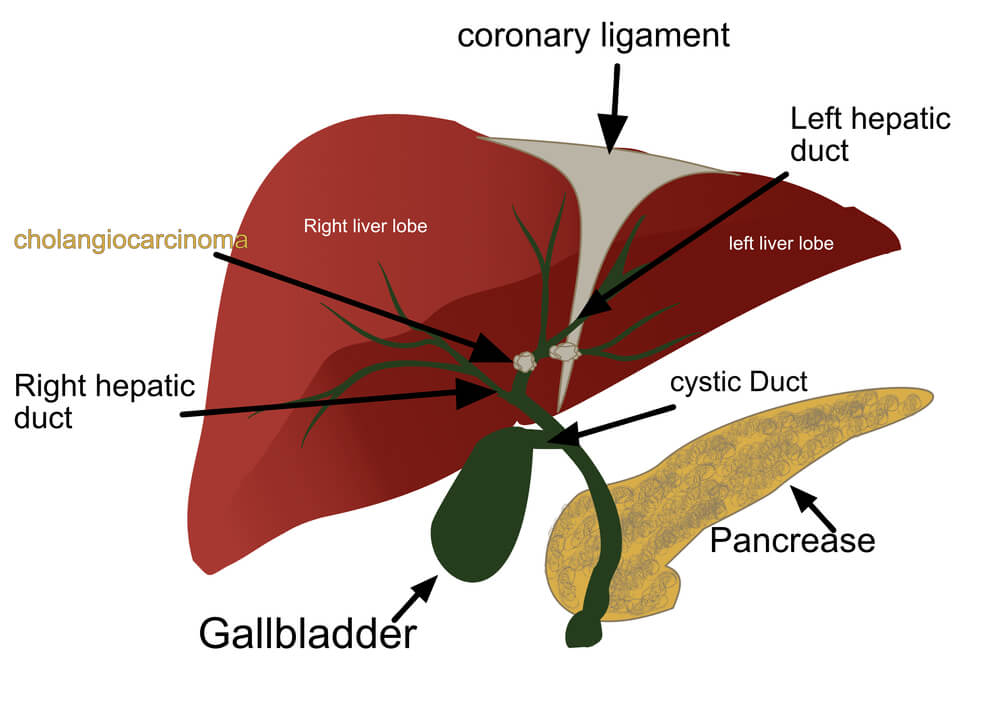Bile duct cancer or cholangiocarcinoma is a rare malignancy that forms in the bile ducts or the thin tubes responsible for delivering the fluid aiding digestion (bile) from the gallbladder and liver to the small intestine.
Most patients get diagnosed with cholangiocarcinoma in later stages when the malignancy has already managed to spread to other organs near the bile ducts. Unfortunately, bile duct cancer treatment may prove to be challenging, and bile duct cancer prognosis might not be the most optimistic, but still, thanks to the advancements in modern medicine, new clinical trials and the implementation of new, targeted therapies may significantly improve the chances of recovery.
Overall, the malignancy is quite rare, with about 8,000 new cases developing in the US each year. Usually, the patients who receive a diagnosis are around the age of 70.
Cholangiocarcinoma Types
Experts differentiate between three main bile duct cancer types:
- Gallbladder cancer: a type of malignancy that forms in the gallbladder.
- Extrahepatic bile duct cancer: This malignancy is the most common and usually originates from outside the liver, meaning that cancer may be present in either the area near the small intestine or near the liver. Hilar cholangiocarcinoma is a subset of this cancer type, which forms in the area where blood vessels and ducts connect with the liver, otherwise known as the hilum.
- Intrahepatic cholangiocarcinoma: This disease starts inside the liver. Still, intrahepatic cholangiocarcinoma and liver cancer aren’t the same. The latter is called HCC, or hepatocellular carcinoma.

Bile Duct Cancer Risks
Several risk factors may help trigger cholangiocarcinoma, and the most prevalent are:
- Certain abnormalities in the area where the pancreatic and the bile duct meet.
- Bile duct cysts.
- Ulcerative colitis (chronic).
- Liver cirrhosis.
- Clonorchiasis.
- Hepatitis C and/or Hepatitis B.
- HIV.
- IBD or inflammatory bowel disease
- Primary sclerosing cholangitis
- Non-alcoholic fatty liver disease
Additional bile duct cancer risk factors usually include:
- Toxin exposure
- Obesity
- Diabetes
- Consuming too much alcohol
- Smoking
Cholangiocarcinoma Symptoms and Causes
As in the case of other malignancies, experts don’t really understand the exact causes of bile duct cancer. Based on the established risk factors, professionals believe that conditions that result in the long-term inflammation of the ducts may play a crucial role in the development of the malignancy. The constant inflammation may cause changes in the DNA, affecting the growth and behavior of certain cells in the ducts. Experts also speculate that these changes may happen during the patient’s lifetime, and they aren’t hereditary like in the case of some other cancers.
When assessing cholangiocarcinoma symptoms, doctors usually look for the following signs:
- Fever
- Pain in the abdominal area
- Dark urine
- Itchy skin
- A condition when the whites of the eyes and the skin turn yellow (Jaundice)
- Vomiting and nausea
- Unintended weight loss
- Light-colored passing stool
Diagnosing Bile Duct Cancer
Diagnosis usually starts when the healthcare provider evaluates the patient’s symptoms, performs a physical exam, and thoroughly examines their medical history. If they suspect cholangiocarcinoma, they may advise the following tests:
- Tumor marker tests: Looking at specific substances and proteins in the blood and urine that might signal cancer.
- Testing liver functions: These tests also look at certain signs which might indicate that the liver isn’t working properly or if there are elevated liver enzymes or bile duct blockage problems.
- Abdominal ultrasound: This type of imaging may be the first test a doctor recommends if they suspect bile duct cancer.
- MRCP: Magnetic resonance cholangiopancreatography is an imaging test with the help of an MRI machine.
- ERCP: Endoscopic retrograde cholangiopancreatography is an imaging test that uses a catheter and endoscope to help professionals establish whether the disease is present or not.
- PTC: Percutaneous transhepatic cholangiography is used to create X-ray images of the ducts, but with the help of a needle that’s directly inserted into the liver and ducts.
Suppose any of these tests indicate bile duct cancer. In that case, doctors may opt for performing a biopsy or taking a tissue sample of the suspicious area to examine the tissue for cancer.
If the biopsy test comes back positive for cholangiocarcinoma, experts usually continue trying to evaluate the stage of the disease. In the case of bile duct cancer, they look at the tumor’s size and whether it has spread outside the ducts.
The disease may spread to:
- The nearby blood vessels
- The nearby lymph nodes and vessels
- The liver and the gallbladder
- Distant organs, like bones, lungs, or the abdominal cavity
Bile Duct Cancer Treatment
The course of action regarding treatment will mostly depend on where the malignancy is located and its stage. Early cholangiocarcinoma may be treated with surgery, but if cancer has spread, experts may recommend a combination of different treatments.
Surgery
In terms of surgery, there are several actions doctors may recommend:
- Bile duct removal: removing the affected part of the duct.
- Whipple procedure: removes the bile duct, gallbladder, part of the pancreas, part of the small intestine, and stomach.
- Partial hepatectomy: an operation that removes parts of the liver and bile duct.
- Liver transplant
- Palliative surgery is for easing cholangiocarcinoma symptoms, as the surgery helps with removing bile duct blockages.
Radiation Therapy
This might be recommended following surgery, as the radiation beams can help kill remaining cancer cells in the body. Experts may also recommend it before surgery to help shrink the tumors.
Chemotherapy
Chemotherapy drugs can also destroy cancer cells or can shrink tumors to make surgery easier or possible. It may also help reduce some of the symptoms of the disease.
The drugs may sometimes be delivered directly into the bile duct. These methods are:
- TACE or Transarterial chemoembolization: A catheter is used to implant tiny beads in the tumor-supplying blood vessels blocking blood supply and releasing chemo drugs to shrink the tumor.
- HAI or Hepatic artery infusion: A pump is surgically implanted to pump chemo drugs to the main artery that pumps blood to the liver.
Targeted Therapy
These methods target specific cancer cell parts.
Immunotherapy
These strategies help the immune system fight malignancy.
Prevention
Unfortunately, there’s no guaranteed way to eliminate the risk of bile duct cancer completely, but people can reduce their chances by:
- Maintaining a healthy body weight
- Limit their alcohol intake
- Avoid hepatitis B and C, and HIV
- Avoid smoking

Getting Professional Help
As mentioned earlier, the bile duct cancer prognosis may be frightening. Still, those patients who report any suspicious symptoms early on to their doctors have a significantly better chance of making a full recovery. On the other hand, modern medicine has also made tremendous advancements in cancer treatment overall, improving outlooks and outcomes tremendously.
While receiving a bile duct malignancy prognosis or even suspecting the disease may be intimidating, patients should still know that with the help of the right professionals and state-of-the-art treatment methods, they can get through these difficult times.
As such, feel free to reach out to Dr. Omar Rashid to learn more about the disease and potential treatment options.


